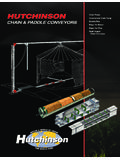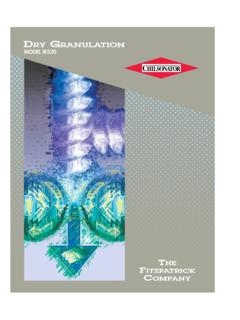Transcription of Gas-Solid-Ejectors: Design Variants and Applications
1 Gas-Solid-Ejectors: Design Variants and ApplicationsKS-EngineeringNiehler Str. 151-153, 50733 Cologne, GermanyVolume 11 / No. 3 July / September/ 1999 Reprint frompowder handling & transport systems have been known for along time now and have already been the subject of detailed in-vestigations [1-5]. Whereas ejector transport has previouslybeen considered under its basic and/or theoretical aspects, andalso the advantages and disadvantages compared with othertransport processes have been worked out, we shall now bedealing primarily with the diverse variations in ejector Design andtheir possible practical Applications . On the basis of concretejob requirements ejector Design , dimensioning and material se-lection will be explained and the potential customer providedwith the detailed information which he can use for Design of ejector Transport An Functional PrincipleThe successful use of the gas-solids- ejector as a feederand/or transport device in a pneumatic transport line is basedon the dynamic sealing of the pressurised transport lineagainst the dosing organ arranged above the intake zone.
2 Thepotential pressure energy of the driving medium (usually air) isconverted in the driving nozzle into kinetic energy. As a result,and given correct Design , a slight negative pressure whichfavours the intake of transport material is set up in the intakezone. Material is, in short, "sucked" into the transport line. Inthe downstream diffusor, the kinetic energy is converted backinto potential (pressure) energy again, since this is the type ofenergy required for the subsequent transport of the account of the substantial frictional losses (wall friction,inter-molecular friction) which occur particularly at high speedsin the driving and catchment nozzles, and also in the first diffu-sor section, and the losses involved in accelerating the mater-ial, the initial potential energy available before the ejector can-not be completely recaptured in the diffusor.
3 A measure ofthese losses is the gas-solids- ejector efficiency, whose valuemay be in the range of to , depending on the quality ofthe Design , the material to be transported and the Advantages compared to other Feeding and/or Trans-port Processes in Dilute Phase Conveying ( RotaryValve Systems with Feed Shoe, Screw Pumps etc.)As already stated in topic , the greatest advantage of gas-solids- ejector resides in the negative pressure mode of opera-tion. With other systems, leakage air, which always occurs inthe absence of dynamic sealing, may either lead to increasedwear in the proportioning organ ( rotary valve) or may act asa hindrance to material intake.
4 This is in particular the case withmaterial which does not flow easily, very light or fine-grainedflows, as well as bulk materials which exhibit a high air retentioncapability and an inclination to bridge formation ( slakedlime, filter dust). Further advantages of ejector transport are itsvery dependable operation with continuous material input, thelow maintenance requirement and, as the further description willshow, its very wide range of application. Finally, ejector trans-port is characterised also by the low cost for instrumentationand control compared to other Feed and/or TransportProcesses with Dense Phase Conveying ( EjectorVessel Transport, Screw Pump):The advantages essentially lie in the lower capital investment re-quirement for an ejector conveyor system, which results fromlower component and control equipment costs.
5 Further advan-tages which should be mentioned are: Higher temperatures are possible Less inclination to plugging Continuous dusts which tend to caking, continuous operation has con-siderable advantages. Batch processing with pressure vesselconveyors, where the material in some cases stands in the ves-sel for long periods, can lead to very considerable problems, forexample due to Disadvantages Compared to other Feed and/orTransport ProcessesThe limitations on the possible Applications concerning trans-port capacity and transport distance can be cited in the firstplace as the major disadvantages of ejector transport. The rea-sons are primarily rooted in the energy consumption required byejector transport.
6 The energy losses described in and theenergy input required on account of the material load which islimited in general to 3 - 4, mean that other systems are better forhigh carrying capacities and/or longer transport Limitations on the Use of ejector TransportFig. 1 presents the favourable field for ejector transport with re-gard to transport capacity and transport distance which resultsfrom the explanations in section The attainable transport ca-pacity with the respective equipment dimensioning is plottedagainst the transport distance. The curves result from a calcula-tion of the pressure drop with well-known calculation methods fora typical boiler ash from the 2nd pass in a refuse incinerationplant.
7 Since the attainable transport capacity also depends on thematerial characteristics (such as for example density and particlesize/size distribution), the transport curves for other materials : Scope of ejector transportGas-Solid-Ejectors: Design Variants and Jan Behrendt Ingenieurb ro Schneider f r Umwelt & Verfahrenstechnikbe different from these. In the parameter key, the Design data ofthe Roots blowers (air quantity, shaft power consumption) whichare mainly used as the air suppliers are listed as required for thedimensions of the transport line. The energy demand for thetransport of 3 t/h over a distance of approx. 60 m is, as can beseen, at approx.
8 25 kW quite high, and its practical realisationpresumably therefore reasonable only in exceptional cases (Ap-plication 2, see below). Other transport processes are thereforepreferred in those areas where ejectors are not a feasible should be noted that this representation only provides a roughindication for the feasibility of ejector transport. An individualconsideration and a confirmatory calculation is absolutely nec-essary for every individual Ejectors: Typical ApplicationsThe standard line of products is characterised by a robust andcompact Design . In effect, the ejector is a casing (welded steelconstruction) into which the nozzle and the diffusor are insertedand fixed in position.
9 The nozzle is adjustable, while the diffusorcan be easily replaced (as a wear part). The ejector is equippedas standard with an inlet pressure gauge. An inspection open-ing can be integrated upon request. Depending on materialproperties, the bottom may be blanked off or executed as a flu-idising floor. The ejector is described more detailed in [1]. Problem: Wear Behaviour of the Bulk MaterialThe example considered is the transport of boiler ash from the2nd pass of a North German RIP. The conveying plant has beenin operation for one year. The requirement was as follows:Bulk material:Boiler ash from 2nd pass of an RIPBulk density:approx. 700-800 kg/m3 Particle size:approx.
10 0-3 mmTemperature:approx. 80 CTransport capacity normal:approx. 600 kg/h for 7000 h/aTransport capacity max.:approx. 800 -1000 kg/hTransport distance:45 m to an ash silo,25 m thereof verticalBends:4-off, ea. 90 A pressure drop calculation (as well as a glance at Fig. 1) showsthat the required dimensioning of ejector and transport line isDN 80. A Roots blower was selected on the basis of the designdata of 350 m3/h volumetric flow intake condition) and 800mbar pressure boost (15 kW motor). The ejector itself is con-structed completely of St 37-2. In the transition, a check valve isarranged which opens at a defined negative pressure and thusallows leakage air to enter the transport line as well.




